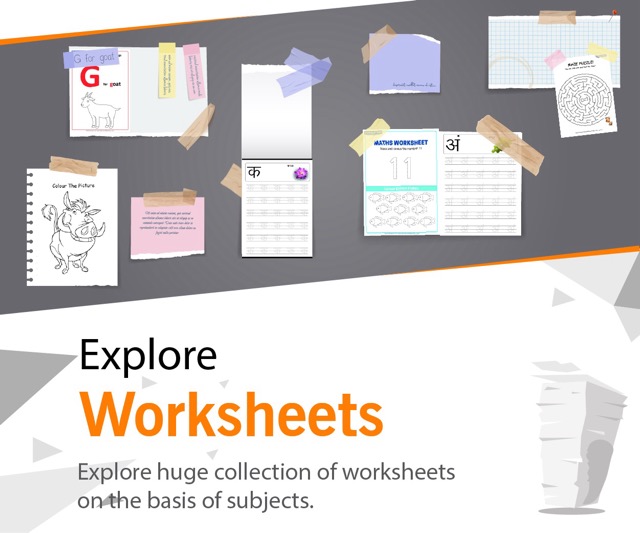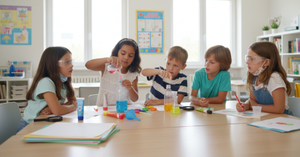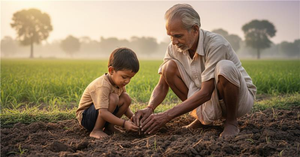Homemade pizza, pancakes, and scrambled eggs are three of our favorite meals to cook together at home. Cooking together as a family has so many benefits. First, we all need to eat. Cooking together is also built-in family time. And as your child grows older, so do the complexities of what they can help you do in the kitchen.
It’s good to start early. Setting up a family routine, creating a family tradition, like cooking together as a family, will continue long after they’ve moved out when they come home for visits. And because we all need to eat, we all need to know how to cook cheap, nutritious meals at home. Such a skill is a beautiful and essential high school or senior school graduation gift!
Here are three meals I enjoy cooking with our six-year-old daughter. More importantly, here are three meals and three ways we make these meals that work for us. I’m not a trained chef, but I am a dad with about six years of experience cooking with a kid.
Each meal includes what you need, how we do it, a few pro-tips, and advice on how to make the experience fun that we’ve learned along the way. Two of the meals here are vegetarian and one is non-vegetarian.
Scrambled Eggs
I love scrambled eggs. I love scrambled eggs too much.
In the past, doctors recommended we stick to egg whites because of cholesterol. But oh, what a glorious day when these same doctors discovered that the cholesterol in egg yolks doesn’t affect the levels of blood cholesterol as much as previously thought. And come on, egg whites aren’t even close to being as good as the whole egg.
My daughter has watched me cook scrambled eggs, basically, since she was born. So, it makes sense this was the first meal or dish she learned to make on her own.
Scrambled Eggs, What You Need
What do you need to prepare scrambled eggs? Here’s how we do it:
- Eggs, of course
- Splash of milk
- Butter or Pam
- A large bowl and a fork, whisk, etc.
Scrambled Eggs, How We Do It
For a fun exercise, do a Google search for “scrambled eggs” and see how many ways there are to make scrambled eggs. In writing this blog, I learned that adding a splash of milk actually doesn’t make my scrambled eggs creamier. Well, my Grandmother, bless her soul, would disagree.
I start with scrambled eggs because one of the first actual activities my daughter could do after watching me cook is stirring or scrambling an egg. This is why I suggest having a large bowl, for spills, and a fork, whisk, or even a chopstick to scramble the egg with. Basically, whatever is most comfortable and age-appropriate for your child to scramble with does not matter. Hold the bowl and let them at it. Joy, Joy, Joy.
Then, in memory of my Grandmother, I add a splash of milk. As your child grows older, you can let them add the milk. But be warned, too much milk is not a good look, feel, or taste, for a dish of scrambled eggs. Best to start over or add many more eggs to even out the ratio. I have first-hand experience when it comes to this tip.
Next, heat the pan over medium to high heat, though I just read another blog that suggested “low and slow,” low heat cooked slowly. Not in our house.
What I like to do is get the pan fairly hot, add the butter, spread it around to coat the pan evenly, throw in the scrambled eggs and immediately began to move the eggs around until they’re ready. Watch those eggs carefully and take them out a bit early– they continue to cook after you take them off the burner.
Scrambled Eggs, Pro Tips
Here are a few tips and observations on how to involve your child.
- After scrambling the eggs, the next job our daughter learned was cracking the egg. Somewhere around age four, my daughter started to want to crack the eggs. I remember she was actually quite adept at holding and handling the egg. I mean, she’d watched my wife, and I crack a hundred eggs at this point. It was how confidently she smashed or cracked the egg that was the problem. By the age of five, she knew how to crack an egg with little or no shell.
- Instead of butter, to make scrambled eggs healthier, try a cooking spray like Pam. While nothing beats the taste of butter, this is one of those healthy substitutions I often don’t notice (unlike low-fat cheese, which is terrible).
- At six years old, while I will allow our daughter up on her step stool and stand next to me while the eggs cook, I only allow her to pour the uncooked eggs into the pan and move the eggs with a spatula. At this point, she doesn’t take the pan off the stove, turn on or off the stove or move the eggs without me being next to her. Not sure when these actions will be appropriate, but she’s not ready yet.
- My second favorite dish to scrambled eggs is an egg sandwich: whole wheat toast, scrambled eggs, and cheddar cheese. Scrambled eggs also make a great dish our kids can make for a Mother’s Day or birthday breakfast in bed for mom.
How to Make Preparing Scrambled Eggs Fun
Beyond cracking and mixing the eggs, we’ve used scrambled eggs as the hair or beard on a pancake face, see the next dish! On birthdays, Mothers Day and Fathers Day, we like to do breakfast in bed for whoever’s special day it is. Scrambled eggs are a great dish our daughter can almost make on her own. So, the dish is a source of pride in terms of how she contributes to preparing breakfast.
Pancakes
Pancakes, specifically making silly faces with pancakes, is my wife’s brainchild. She did this a year or so before our daughter was born with her niece and nephew, and it was a hit. One of the best things about preparing scrambled eggs and pancakes is that the process does not take too long, and the risk of a spill or injury can be easily minimalized.
Pancakes, What You Need
Here is how we prepare pancakes:
- Pancake Mix. This is how I do it! All you have to do is add water.
OR
- Flour, baking powder, salt, and an egg (optional). This is how my wife does it.
- Water or Milk
- Butter or Pam
- A large bowl and a fork, whisk, etc.
Pancakes, How We Do It
While my wife will make pancakes from scratch, I prefer the simpler method of just using a ready to go pancake mix– just add water or milk.
I follow the directions on the pancake mix box. Measure the appropriate amount of mix on the digital scale. Measure the appropriate amount of water in the measuring cup. And combine both into a large bowl for my daughter to mix. “Dumping” and “stirring” being the two easiest cooking skills, kids can usually help with this dish from the age of two.
Next, heat the pan over medium-high heat. Add a small amount of butter, spread it around to coat the pan evenly, and pour the pancake batter into the pan. How large the pancake depends on how much mixture you pour.
Once you begin to see bubbles forming on the pancake’s uncooked side, it’s ready to flip. Once you’ve flipped the pancake, it takes less than half the time you cooked the first side of the pancake before it’s ready to eat.
Pancakes, Pro Tips
Here are a few earned and learned tips when making pancakes with your child:
- If you use a ready to go pancake mix, work out the ratio of mix to water they give you on the box and how much is needed to make two pancakes. Our daughter loves pancakes more than I do, and for a while, I made more pancakes that we needed. I tired of feeding leftover pancakes to our dog Taco, so like so many things in my life, I realized I could simply work out the ratio and make what my daughter needed. Everyone is happy except Taco.
- Use a digital scale to measure out the pancake mix. If you don’t have a digital scale for cooking, here’s a pro-tip, buy one. And a meat thermometer.
- With the digital scale for the pancake mix and a measuring cup for the water, this is a great opportunity and activity for your child to learn how to measure and practice math, like figuring out the correct ratio.
- Like scrambled eggs, use a large bowl and an age-appropriate utensil to mix with. Also, like scrambled eggs, somewhere around five years old, I allowed my daughter to stand next to me on her stool while the pancakes cooked. One of the responsibilities I give her is to let me know when a pancake is ready to be flipped. I will also hold the spatula with her and flip the pancake together.
How to Make Preparing Pancakes Fun
How to make preparing pancakes fun? You have so many options.
- First, prepare a round pancake and make a face. Use fruit, like bananas and blueberries, cookie and cake toppings like sprinkles, chocolate chips, gummy bears, and whatever else you can come up with (scrambled eggs for the hair?) to make the eyes, nose, mouth, ears, eyebrows for your pancake face. There are literally no rules or limits to the vision of you or your child’s imagination.
- Second, take metal cookie cutters, spray the inside of them with PAM, place the cookie-cutter on the hot pan, and pour the pancake mix inside. Just like regular pancakes, when you see the bubbles, you know you’re ready to flip. Now, this takes some skill, but after a few, you’ll figure it out. I like to take tongs, grip the cookie-cutter, give it a couple of solid shakes, and if you’ve applied enough PAM the pancake should fall out. Now you can flip the cookie-cut pancake with a spatula. We have various animals and shapes like hearts we make pancakes with. Afterward, just like the face, you can decorate the shaped pancakes.
- Third, I’m somewhat of a ninja master when it comes to making pancakes, so sometimes I like to flip the pancake while it’s in the pan. Shake the pan back and forth before flipping to make sure it doesn’t stick, then give it a flip. Oh man, the kiddo will love it.
- While I like old fashioned butter and maple syrup on my pancake, for a special treat, we’ll allow a thin layer of Nutella or powdered sugar.
- Last, if you have a group of cousins or friends over, making and decorating face pancakes together as a morning activity can’t be beat.
Homemade Pizza
Another excellent group activity is making individual homemade pizzas. This is the dad-approved, simple way of making homemade pizzas.
Homemade Pizza, What Your Need
- Premade pizza crust you can buy at Mother Dairy or your local grocery store
- Premade pizza sauce
- Olive Oil
- Shredded cheese
- Toppings
Homemade Pizza, How We Do It
Of course, you are free if you have the time and know-how to make your own pizza crust and sauce from scratch. But I’m keeping it real, this is how I get by, and it’s also still delicious. Maybe not as tasty as your homemade crust and sauce, but it does the trick.
Preheat the oven, spread a thin layer of olive oil on your pizza crust, and heat it for five to ten minutes until it’s a bit crunchy. If you don’t have an oven, you can even improvise on a gas stove.
Take the pizza crust out, add your pizza sauce, then your cheese and toppings.
Stick the pizza in the oven or toaster until the cheese is melted the way you like it, and voila, homemade pizza!
Homemade Pizza, Pro Tips
- The biggest issue with pre-made pizza crust is to make it crisp. If you like a softer crust, then it’s no problem. There are certain tradeoffs when it comes to not making your pizza crust and sauce homemade, but the flavor you do get, the ease, and time saved are well worth it for me.
- Prepare your toppings and have your cheese ready to go before placing the crust in the oven.
- If you have several kids making pizza together, go ahead and spread the olive oil on the pizza crusts you need and brown them before the kids start adding toppings. This way, all the kids can make their pizza together.
How to Make Preparing Homemade Pizza Fun
Here a few ideas we’ve come up with:
- Let your child or the kids choose their own toppings. Then put them to work finding and preparing their toppings.
- If you’re feeling a bit rambunctious, make a crazy pizza with unfamiliar toppings. How about chocolate on your pizza, or a gummy bear, why not?
- If you have a group of kids over, give a prize for the best tasting, best looking, best smelling, most creative pizza. You can make it a competition or just come up with enough different kinds of prizes, so everyone gets one.
If you have any examples of other fun dishes or pro-tips you’ve earned when making a meal with your child, please share it in the comments below.









Be the first one to comment on this story.